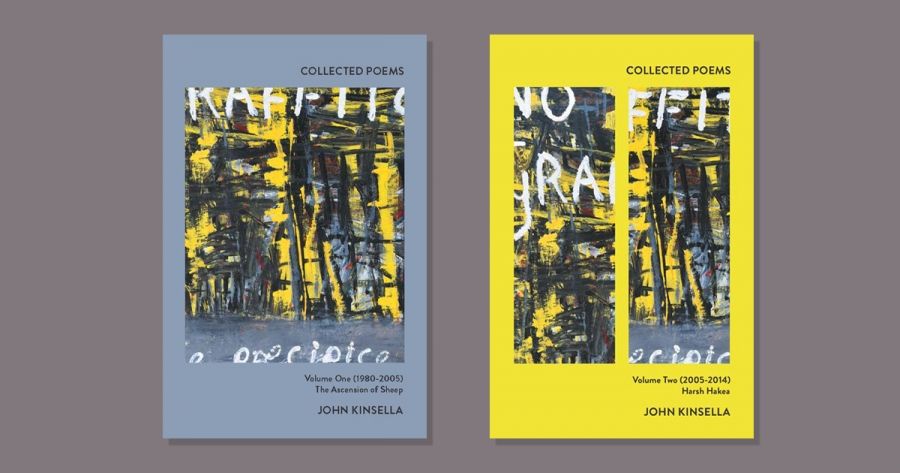
- Free Article: No
- Contents Category: Poetry
- Custom Article Title: Collected Poems, Vol. 1 & 2 by John Kinsella
- Review Article: Yes
- Article Title: 'The heritage I bring'
- Article Subtitle: The gargantuan poetry of John Kinsella
- Online Only: No
- Custom Highlight Text:
A quarter of a century has passed since Ivor Indyk contributed a scathing review of John Kinsella’s first collected poems to the pages of ABR (July 1997), and the contending responses to that opinion have typified the reception of his poetry among the vituperative local poetry community ever since. This extravagant representation of his work – two volumes of close to a thousand pages each, with a third volume pending – might seem almost deliberately designed to expose the author to similar criticism. Rather than a conventionally shaped collected edition, this is more like a throwing open of filing cabinets, and the nearly 1,700 pages presented so far are certainly not all masterpieces.
- Featured Image (400px * 250px):
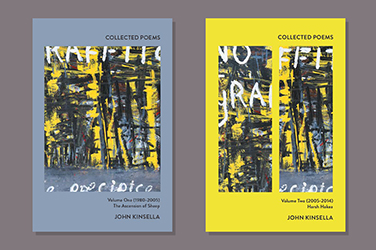
- Alt Tag (Featured Image): John Hawke reviews 'Collected Poems: Volume One (1980–2005), The Ascension of Sheep', and 'Collected Poems: Volume Two (2005–2014), Harsh Hakea' by John Kinsella
- Book 1 Title: Collected Poems
- Book 1 Subtitle: Volume One (1980–2005), The Ascension of Sheep
- Book 1 Biblio: UWAP, $55 pb, 804 pp
- Book 1 Cover Small (400 x 600):
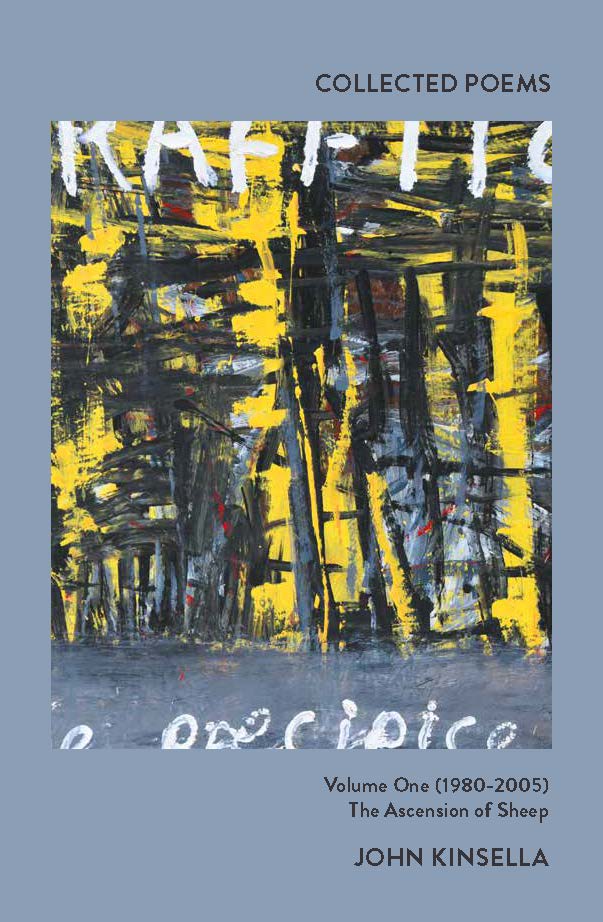
- Book 1 Cover (800 x 1200):

- Book 2 Title: Collected Poems
- Book 2 Subtitle: Volume Two (2005–2014), Harsh Hakea
- Book 2 Biblio: UWAP, $55 pb, 829 pp
- Book 2 Cover Small (400 x 600):
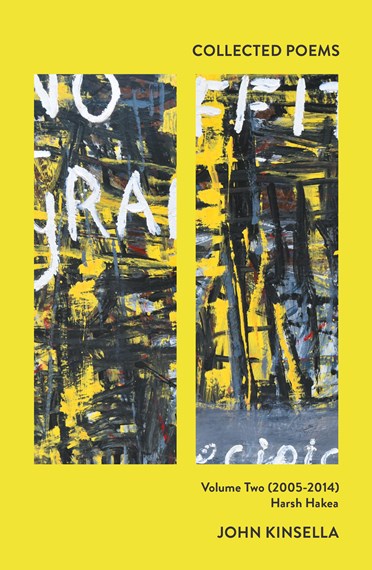
- Book 2 Cover (800 x 1200):

The rural portraits of Robert Frost seem another key influence: an ecological theme, delivered in Frostian monologue, emerges in ‘Death Side by Side, From the Top Down’, and rural description becomes the focus of poems such as ‘Two Days Before Harvest’ in Eschatologies (1991). Les Murray provides an obvious model for this approach – ‘Wells’ perfectly mimics Murray’s observational directness – though the success of Philip Hodgins’s poetry at the time may also have figured in this. Certainly, the attention to lived experience revealed in these poems is more natural to Kinsella than attempts at symbolist exoticism such as his Brennanite ‘Lilith’ sequence; and the incorporation of cultural references in Full Fathom Five (1993), the volume which most reflects Robert Adamson’s interests, can also seem imposed.
Syzygy (1993) is Kinsella’s real breakthrough work: for the first time we find him eschewing the orthodoxies of description to allow language some autonomy: familiar rural subjects appear, but liberated from the debt to mimesis of Dickey, Murray, and Hodgins. Silo (1995), published not long after, offers an opposite approach, but is similarly corrective: following the merciless example of Adamson’s Where I Come From (1979), the stripped-back prosaic style of these poems reflects their anti-romantic undercutting of the conventions of rural idyll. This is the commencement of Kinsella’s concern with an ‘antipastoral’ depiction of environmental degradation, and there is at least a nod to the Lawson tradition in these descriptions of the exigencies of rural labour.
By this stage, Kinsella was moving beyond nationalist concerns, and forging international connections via email and travel. The poems of Erratum/Framed, which appeared in the same year, reflect the influence of language-centred Cambridge poets such as J.H. Prynne, and provide a record of widening engagement with developments in international poetics (Susan Howe, Lyn Hejinian, and Jacques Derrida are personally invoked). The voice of ‘A Zone Essay on Prohibition and Purity’, expansive and relentless, presents a new and exciting aspect to his range.
Kinsella’s most anthologised work begins to emerge in the fluent diaristic style of Lightning Tree (1996), with its commitment to place and personal history, directly stated in ‘Heading South through the Long Paddock’: ‘But this is the heritage / I bring with me, / and there’s no denying it.’ This recognition leads to the key poems of The Hunt (1997): violently dystopian in their Grand Guignol depiction of ecological destruction, their densely layered diction directly invokes the sound-play of Murray, the dedicatee of the arresting title-poem. After this achievement, though, his attention drifts: the poems written in England are looser and more meditative; there are experiments with procedural techniques; ‘The Benefaction’ (1999) is an interesting anti-colonialist refiguration based on the found-text of George Grey’s journals of exploration; while Visitants (1999) seems a frankly weird attempt to locate Lovecraft within a wheatbelt setting.
Kinsella seems to use these often equivocal experiments as a means of renewing the main stream of his practice. He returns to harsh rural reportage in The Hierarchy of Sheep (2001), where the touch of Frost once again emerges in the portraiture of ‘Firebox’. More involving, though, is the documentary approach adopted in a sequence on the Avon River (2002). This objective viewpoint carries into Peripheral Light (2003), certainly one of his best books, where the Cambridge influence is evident in a phenomenological receptiveness that allows the world to speak through the poem. The development of a more mature style emerges from this shift: The New Arcadia (2005) is another rediscovery of country, but this time figured in terms of personal experience, rather than as observer or portraitist, and this presages the direction of his work over the next decade.
In his 2015 essay, ‘Is There an Australian Pastoral Poetry?’, Andrew Taylor identifies the movement toward ‘integration’ and ‘place-connectedness’ in Kinsella’s poetry of this period, which he likens to Murray’s return to his home country of Bunyah. This is signalled in the journal-like approach of Shades of the Sublime and Beautiful (2008), opening out through step-lined phrases in the manner of Paul Blackburn, in which the documentation of domestic life is connated with a personalised mapping of landscape.
There is a deliberate (sublime?) unfinished quality to these writings: while the excellent ‘Wave Motion Light Fixed and Finished’ is fully attentive to its subject, other poems seem to lose focus in polemical declamation, or the kind of obsessive empirical documentation also apparent in the Perth poems of ‘Sand’. A similar, almost wilful, looseness of style is deployed in his ‘activist poems’ from this period, collected in The Vision of Error (2013).
Kinsella returns to the ‘well-made poem’ through the solidifying quatrains of Armour (2011). The Murray-like breadth of observation and transformative absorption of the natural world evident here leads directly to his major work of this period, the award-winning Jam Tree Gully (2012). In its informative cataloguing of settlement, and what Taylor terms its ‘ethics of respect’, Kinsella aligns himself overtly with Thoreau – though a more local correlative for this abundant rendition of the author’s occupation of landscape might be found in Patrick White’s The Tree of Man.
During this period, Kinsella’s working method frequently involved interpolating and measuring himself against major texts in literary history (though work from the lengthy The Divine Comedy [2008] is not included here). A proportion of the second volume is made up of translations, which allow the reader to consider his poetics against a wide range of models. It is not surprising that the detailed Parnassianism of Leconte de Lisle seems the most natural fit for his own stylistic approach. While this summary does not exhaust the range of techniques evident in these two volumes, it is obvious that Kinsella is a poet who favours combination over selection.


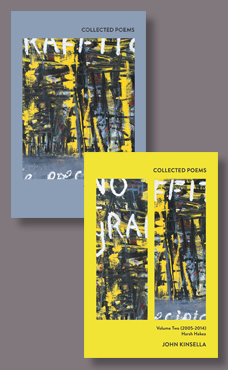
Comments powered by CComment